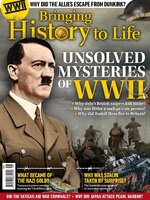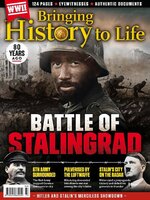In 1933, Adolf Hitler seizes power in Germany, where he has seduced the population with golden promises of a restoration of the Great German Empire. He allies himself with Mussolini's fascist Italy, Stalin's communist Soviet Union and the military dictatorship in Japan, which has the same dreams of grandeur as Germany. In this series, you get a thorough review of World War II - from the birth of fascism through the war's many dramas to the aftermath, where the victors deal with the war's worst criminals.
WELCOME
MOMENT OF DESTINY ON THE EASTERN FRONT • In early 1943, Germany was under pressure on the Eastern Front after its defeat at Stalingrad. Hitler ordered all attacks suspended, but then a proposal from a colonel-general landed on his desk. It highlighted an area near the town of Kursk where the paper’s author believed the Soviets were walking into a trap.
THE CALM BEFORE THE STORM • For three months, from April to July 1943, the Eastern Front was quiet. But there was plenty of activity on both sides behind the lines. The Germans were shipping new planes, tanks and guns to the Kursk Front while the Soviets were busy building defences and devising a strategy to fend off the Germans’ hammer blow.
ARMS RACE TO DECIDE THE WAR • In 1943 Hitler was nervous. The Blitzkrieg against the Soviet Union had become stuck, and he decided that only new wonder weapons could save Germany. Only two things counted to the Führer: size and thick armour. In Moscow, Stalin also dreamed of new weapons to secure victory against German planes and tanks.
Japan did not have the strength to help • As the war on the Eastern Front turned against the Germans, Hitler increasingly insisted that Japan come to the rescue by invading the Soviet Union. But military flare-ups in the 1930s had shaken the empire, which lacked the men for a costly invasion.
ALL HELL BROKE LOOSE • In the summer of 1943, almost 800,000 German soldiers, supported by 3,000 tanks, were ready to attack the Soviet positions at Kursk. The assault was prepared in secrecy – or so the Germans believed. But the Soviets knew all about the plans, and before long, the world’s biggest armoured battle would begin.
CLOSING THE POCKET • The fighting at Kursk surged back and forth for five days. From the north and south, German tanks and soldiers pounded Soviet positions to slowly break through each defensive wall. It was a huge effort that was intent on bringing the two German forces together in a pincer movement to close the pocket at Kursk.
DEATH MATCH ON THE PLAIN • On 12th July, German panzer corps attempted to advance to the village of Prokhorovka in a last attempt to close the Kursk pocket. There, three German and five Soviet armoured divisions came together with immense force in a chaotic struggle to win the battle. By the end of the day, the Battle of Kursk was decided.
“If you didn’t get killed, you were lucky” • Wolfgang Kloth served first as a private and later as an officer in the German tank divisions. During the fighting at Kursk, he saw the Soviet defensive forces in action on the northern front and witnessed first-hand the German panic when the Red Army launched its counter-offensive.
SOVIETS GO ON THE OFFENSIVE • By mid-July 1943, it was clear that the German offensive against Kursk had stalled. For days, the Soviets had suffered horrific losses, but it was time to strike back. Millions of soldiers were ready to attack. Having only been successful during winter so far, the Red Army had to prove it could also be victorious in summer.
Bringing History to Life

 World War II’s Forgotten battles
World War II’s Forgotten battles
 The Battle of Britain
The Battle of Britain
 Hidden Heroes of War Elite soldiers
Hidden Heroes of War Elite soldiers
 Air War over Germany
Air War over Germany
 The Artic Convoys
The Artic Convoys
 Incredible Weapons
Incredible Weapons
 U-Boat Hunters in the Atlantic
U-Boat Hunters in the Atlantic
 WW2's Darkest Crimes
WW2's Darkest Crimes
 Inside the Third Reich
Inside the Third Reich
 Luftwaffe
Luftwaffe
 The Third Reich - prepared for war
The Third Reich - prepared for war
 Nazi Mysteries
Nazi Mysteries
 Historys Greatest tank Battle
Historys Greatest tank Battle
 Panzer!
Panzer!
 Unsolved Mysteries of WWII
Unsolved Mysteries of WWII
 Fall of Berlin
Fall of Berlin
 Battle of Stalingrad
Battle of Stalingrad
 Special Forces - Equipment! Tactics! Missions!
Special Forces - Equipment! Tactics! Missions!
 The Collapse of Nazi Germany / Western Front
The Collapse of Nazi Germany / Western Front
 Operation Barbarossa
Operation Barbarossa
 Nazi Stormtroopers
Nazi Stormtroopers
 World War II - Key events 1939-1945
World War II - Key events 1939-1945